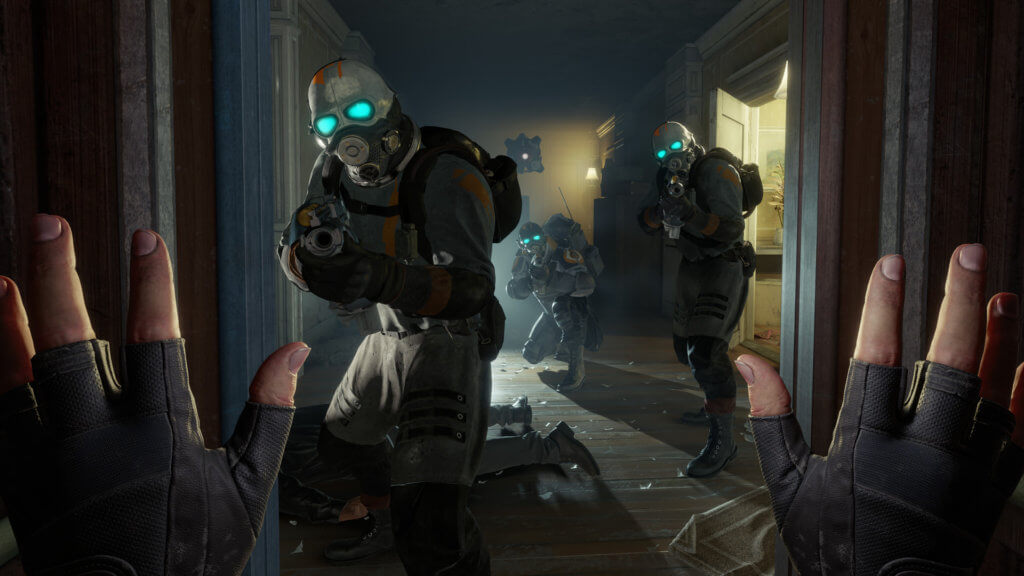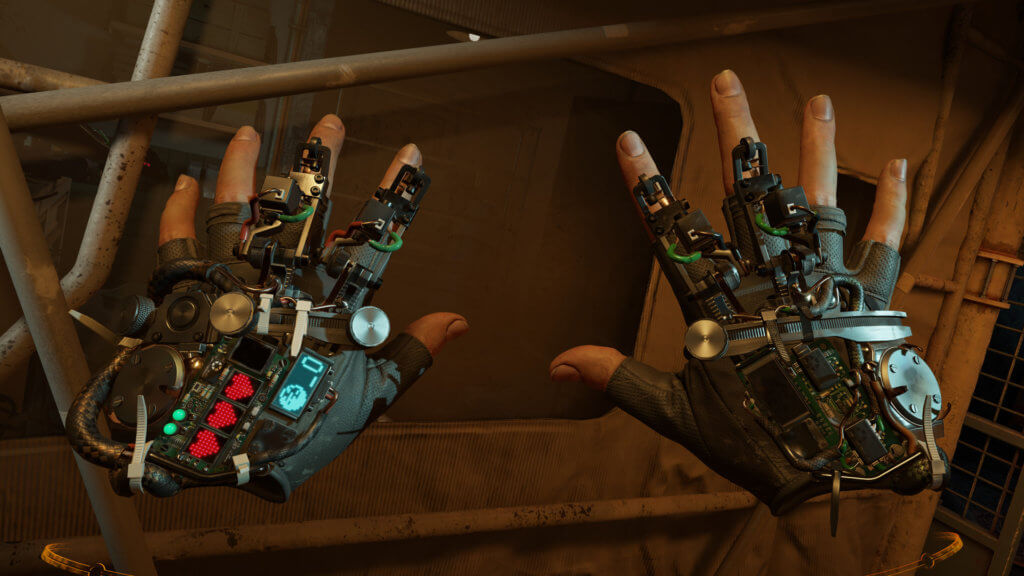What Half-Life: Alyx taught us about Virtual Reality Development

The virtual reality PC game Half-Life: Alyx just had its first birthday, so I wanted to take the opportunity to talk about how great of a Virtual Reality experience playing this game is, and what exactly about it makes it so far ahead of anything else I’ve tried in the genre. This game is very forward thinking and packed with lessons that we can take and apply to developing great virtual reality experiences for our customers.
All in the Hands
When you first start playing Half-Life: Alyx and look down at your hands, it’s apparent they’re more than just a blank-slate-stand-in for your real world hands- these are Alyx’s hands. They’re beat up and dirty. They instantly tell you something about the character, and help make you believe you are her.
Unlike an average VR game where your hands go through things like tables and walls: Alyx’s hands collide with the environment, which adds a lot to immersion. You can lean against a wall, push doors open, brush your hands on a table, and your hands will react flawlessly, with the signature physics we all love Valve games for.
You might think having your virtual hands and real world hands drift out of sync like this would hurt your brain and cause you to become disoriented- but it’s very intuitive in the way that it’s handled, and I’d imagine that most people wouldn’t even notice it’s happening. It feels totally natural.
Interaction with objects like levers, knobs and cranks other instances where your virtual and real world hands will be briefly out of sync. Alyx’s hands will latch onto the object until you let go. This is a technique I first saw applied in Job Simulator, and it works perfectly here too.
The takeaway is: as VR developers, we have to know when to show where the players real hands are, and when to show where their hands should be.

Gravity Gloves and more
The gravity gloves may be Half-Life: Alyx’s greatest innovation. In most virtual reality games, out of reach objects require you to move to and grab, which can be challenging in a limited play space. Additionally, bending over again and again to pick up objects off the ground can be fun at first but can quickly be fatiguing. Not ideal if Valve wants people to actually finish this game.
Enter: the Gravity Gloves. Similar to the Gravity Gun in Valve’s 2004 release Half-Life 2, the gravity gloves allow you to launch objects towards yourself from far away, which you can then catch. This feature not only fits in perfectly with the lore of Half-Life, but it makes the game more accessible and comfortable than any other similar virtual reality game I’ve tried.
Grabbing objects from far away never gets old. The physics involved feel exactly right, and I find myself having to bend down and walk around much less thanks to this feature, which allows me to sink hours into this game without getting tired. It works so well, in fact, that I worry about missing it when I play other VR games. Not every game can come up with an in-universe excuse for you to have the ability to launch objects towards yourself at will.
Another accessibility feature Valve got right is the variety of options available for locomotion. For the uninitiated: how to exactly move around in a virtual world is something that hasn’t been completely ironed out yet. User’s VR play spaces are only so big and Half Life: Alyx offers a huge world to explore, which means you have to move around somehow. Floating around the world like a traditional FPS game will cause even the strongest stomaches to get motion sick eventually.
Different games handle this in different ways: some take place with you standing in one place, like Job Simulator or Beat Saber. Of course, this isn’t an option for an adventure game like Alyx, so Valve offers multiple movement methods. The default is Blink: you hold down the thumbstick, which projects a holographic set of feet out in front of you from where your left hand is pointing. Release the the stick, and the screen quickly fades to black. When if fades back up, you’re standing where you were just pointing. I find this method totally eliminates the sea-sickness I feel when I use a different option, like freely moving around the world with the thumbstick. But the fact that Valve gave multiple options here is key to Half-Life: Alyx’s accessibly.
There’s a lesson here: If you’re making a VR experience that you want people to spend hours in, make sure it’s accessible.

Hands Up Display
Designing user interfaces in VR is always a challenge because the conventions aren’t exactly agreed upon yet. However, it’s clear at this point that it makes much more sense to integrate HUD elements into the virtual world rather than overlay them in front of a users face with no explanation at all. How do you show things like health and an ammo count in a virtual reality game with no heads-up-display?
Valves solution to this in Half-Life: Alyx is two-fold. For health, they integrate the health bar into one of the gravity gloves. You see a simple 3 heart health bar when you look down at your left hand. No obtrusive UI, no pausing, and it fits right into the lore of the game.
Valve also makes intelligent use of audio queues to let the user know how many rounds they have left while they are reloading their gun. When you grab a magazine out of your backpack by reaching over your shoulder, Alyx will say some variation of “two mags left” under her breath, as if she’s counting them out herself. This audio queue eliminates the need for another HUD element- the ammo counter.
What did we learn here? Well, if you want to make your VR experience immersive and believable: find ways to naturally integrate that information into the virtual world that makes sense rather than arbitrarily tacking it on.
Wrap Up
Half-Life: Alyx sets a new standard for virtual reality experiences, and I think it should be used as a reference point for all developers moving forward- even a year later. You can tell Valve put in tonnes of research and effort into what works best in VR and has built out a strong game from those fundamentals, rather than trying to make a traditional first person shooter game work in VR. On top of that, it’s truly a treat to play and offers a gripping narrative paired with highly realistic visuals. If you’ve been waiting for a reason to finally jump in VR, this is it.
While you’re playing Alyx, take some time to think of the possibilities this sort of technology can unlock for your business- wether it be through training, marketing, or simulation. When it comes time to develop an interactive experience that can solve some of your companies toughest challenges, we can help!
